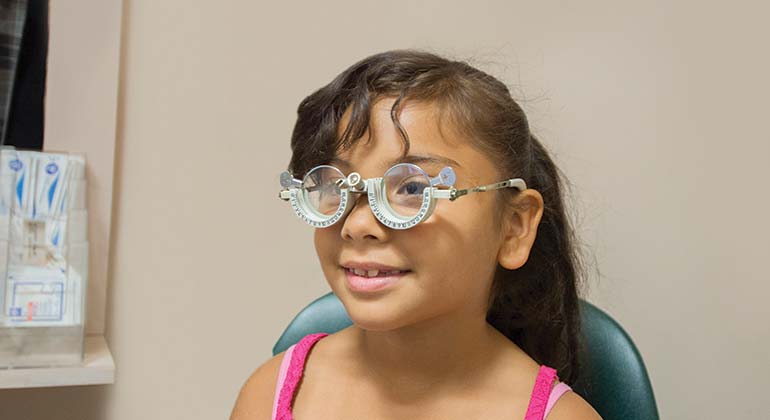
Common Vision Problems
New York Eye and Ear Infirmary of Mount Sinai (NYEE) is home to a team of highly skilled specialists, who have extensive experience treating a wide range of common vision problems in children, including the following:
Myopia
More commonly known as nearsightedness, myopia is a visual condition where a child can clearly see objects that are nearby, but objects farther away appear blurred. Myopia is a refractive disorder causing light entering the eye to be focused in front of instead of directly on the retina. This is the result of an eyeball that is too long or a cornea (the protective outer layer of the eye) that is too curved.
Myopia is usually first seen in school-age children, and progresses until they are around 20 years old. If uncorrected, it can cause headaches, squinting, eye strain, and eye fatigue. Myopia is often hereditary but can still be affected by how a child uses his or her eyes.
Because your child’s academic performance and ability to interact with others may be affected by nearsightedness, it is important that he or she has a comprehensive eye exam in their early school years. While schools often conduct a vision screening for students, it’s not the same as a comprehensive eye exam, which not only checks for visual acuity (distance vision) but for eye movement disorders, farsightedness and other vision problems.
How is Myopia Treated?
Nearsightedness is usually treated with eyeglasses, contact lenses, or laser surgery (where a laser beam of light reshapes the cornea by removing a small amount of eye tissue).
Hyperopia
Children who see objects more clearly at a distance than close-up have a condition known as hyperopia, or farsightedness. Like nearsightedness, farsightedness is a refractive error, but in this case light is focused behind the retina instead of directly on it. This is caused by an eyeball that is too short, or a cornea (the protective outer layer of the eye) that is not curved enough.
Hyperopia often begins in early childhood, though there may be no symptoms. The condition often self-corrects as the child grows. Still, it is important that your child have a comprehensive eye exam at an early age to detect hyperopia, particularly if the condition runs in your family. Vision screenings done at school are not comprehensive exams and are usually unable to detect hyperopia.
Some children with severe hyperopia experience constant blurry images in one or both eyes. The condition can also prevent normal vision development and if not treated result in permanent vision loss.
How is Hyperopia Treated?
Your eye care professional may prescribe eyeglasses or contact lenses that adjust the way light enters the eyes, allowing for improved close-up vision. In mild cases of farsightedness, the eyes may adjust without corrective lenses.
Astigmatism
Astigmatism is so common that almost everyone is born with some degree of it. With astigmatism, your cornea isn’t perfectly round like a marble, but more oval like a spoon. Consequently, light entering the eye is refracted improperly, meaning only part of an object may be in focus, making it appear blurry or wavy, either close-up or at a distance.
While most people are born with astigmatism, it can also result from an eye injury, eye disease or surgery. A standard eye exam is usually sufficient to diagnose the condition in children.
How is Astigmatism Treated?
Eyeglasses or rigid, gas permeable contact lenses that can reshape the curvature of the cornea are usually effective in treating this condition. In the most severe cases laser surgery may be recommended. If the astigmatism is mild, however, no corrective action may be necessary.
Childhood Tearing
Excessive childhood tearing is usually caused by a partial or complete blockage of the tear drainage system. Known medically as nasolacrimal duct obstruction, this condition leaves the eye watery and irritated as a result of tears not being able to drain normally. When the obstruction is present at birth, it can cause the eyelids to become red and swollen with a yellowish-green discharge. The most serious cases can result in infection of the tear duct system. The good news is that nasolacrimal duct obstruction normally resolves on its own within the first year of life.
Roughly five percent of newborns are estimated to have signs of tear drainage system blockage affecting one or both eyes. The condition is usually caused by failure of the membrane at the end of the tear duct to properly open at the time of birth.
How is Nasolacrimal Duct Obstruction Treated?
At New York Eye and Ear Infirmary, we frequently see and treat this condition in a variety of ways. In newborns, we may show parents how to gently massage the tear ducts at home to coax them open. If the condition persists, we may do a technique called tear duct probing where we pass a smooth probe (like a thin, straight wire) through the tear duct into the nose to open the blockage. This procedure is usually done in a hospital operating room on an outpatient basis using topical anesthetic drops so the child feels no discomfort. If that procedure is unsuccessful, we implant a tube in the nasolacrimal duct system, which remains in place for several months to allow for proper drainage.
